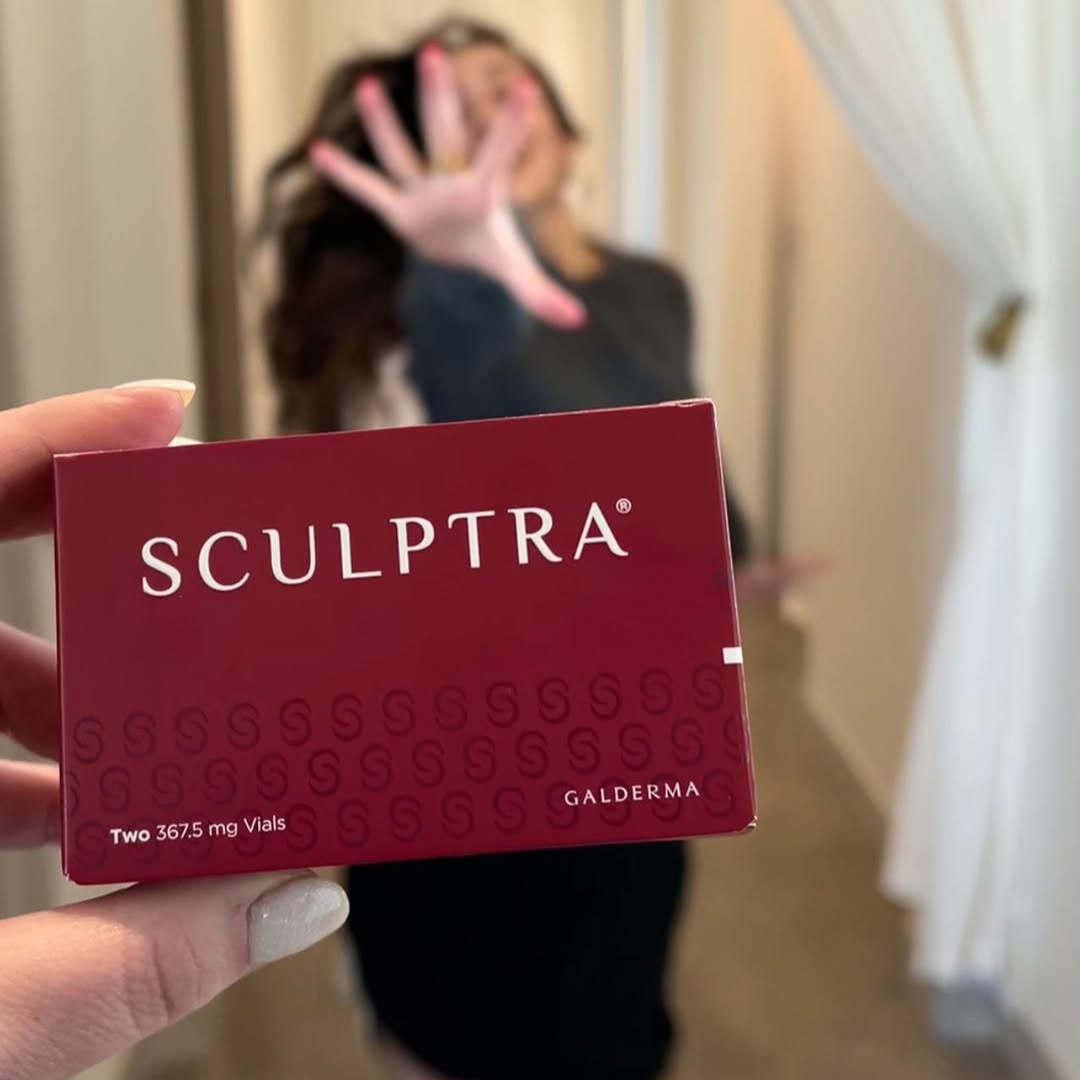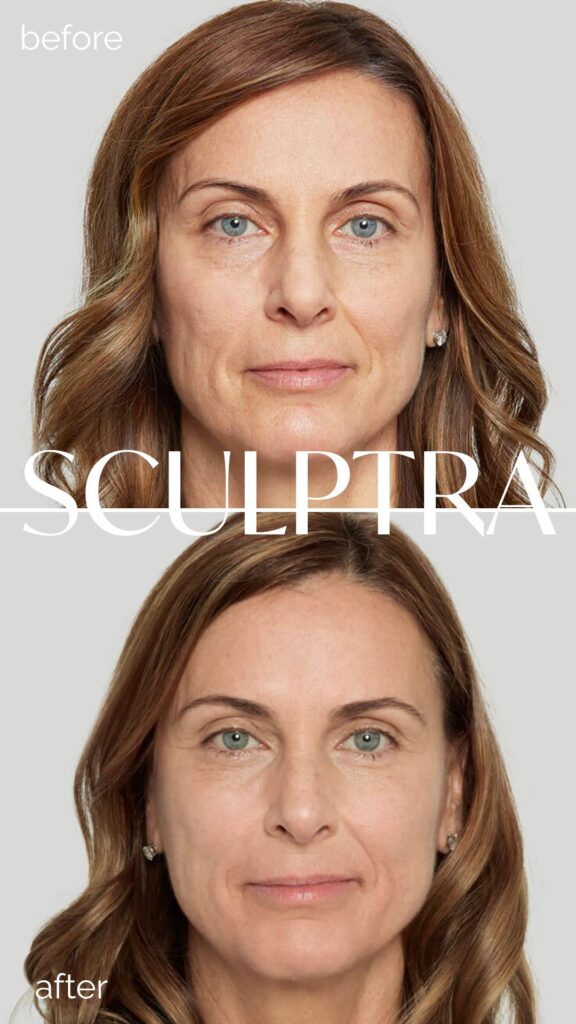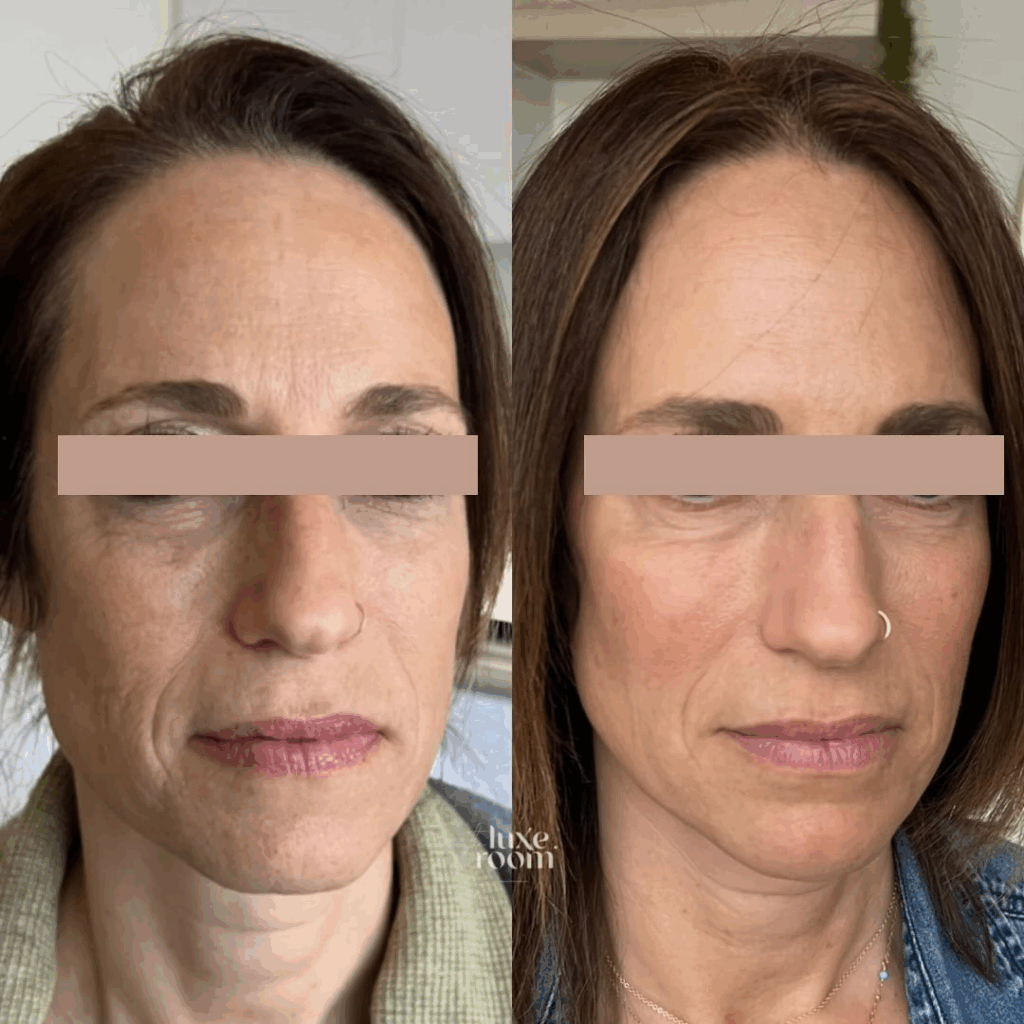Sculptra – Your Anti-Aging Secret Weapon
Beauty trends have officially taken a turn for the subtle. So if your main goal is to look less tired and as youthful as you feel inside, Sculptra is your secret weapon for taking years off your face.
Your friends may notice you got filler or Botox, but they’ll never ask, “Hey, did you get Sculptra done?” Because results are so natural and gradual, you’ll wake up one day and notice you look younger and more refreshed. The kind of change that’s beautiful but you can’t quite put your finger on it. And who doesn’t want that?
What Is Sculptra and Why It’s Gaining Popularity
Before we talk about what Sculptra is and isn’t, let’s quickly cover the basics of aging because when it comes to anti-aging treatments, we need to understand what we’re treating.
First, aging affects the quality of your skin—fine lines, wrinkles, texture issues, hyperpigmentation—they all wreak havoc on our skin as we get older. You can manage these with skincare (sun protection is a must!), microneedling, lasers, and IPL treatments.
Next, there’s the dreaded sagging. That’s when your skin loses elasticity and starts looking less firm. Think jowls, neck laxity, and a longer, tired-looking face. You can prevent sagging through cosmetic procedures, or lift your skin with surgery.
Finally, let’s talk about volume loss—this is where Sculptra truly shines. After our mid-20s, we start losing about 1% of our collagen each year. By the time we hit our late 40s, that means we’ve lost more than 20%, causing our skin to sag and lose fullness, like a deflated balloon. Sculptra beautifully restores this volume, bringing back the plump, youthful look you’ve been missing.
So what is Sculptra?
Sculptra—Galderma’s biostimulatory injectable is an FDA-approved collagen stimulator that’s made of PLLA – poly-L-lactic acid. While Sculptra is categorized as a biostimulatory filler, it’s not filler in a traditional sense – it adds volume to your face by stimulating the production of your own collagen.
Sculptra has been around since the late ’90s, initially helping HIV patients restore facial volume lost due to treatment. Recognizing its potential, doctors soon adapted Sculptra for cosmetic use, leading to its approval in Europe (1999), FDA approval in the US (2004), and cosmetic-specific approval in 2009.

Sculptra Ingredients & How It Works
Sculptra’s main ingredient is PLLA (poly-L-lactic acid), a biopolymer that has been used safely in dissolvable stitches for years. Doctors noticed that where these stitches dissolved, new collagen would form, creating scar tissue and helping the body heal. That’s how they discovered PLLA’s powerful ability to stimulate collagen. In Sculptra, PLLA comes as a powder that’s mixed with sterile water or saline solution and a small amount of local anesthetic (like Lidocaine) before injection.
How Sculptra Works
Once Sculptra is injected, the PLLA goes to work by signaling your skin’s fibroblasts—special cells that produce collagen—to start making more collagen exactly where you need it. You can think of Sculptra as a fertilizer for your cells, helping your body restore volume and build collagen precisely in the areas you want to plump up.
How long does it take for PLLA to leave the body?
Poly-L-lactic acid (PLLA)—the main ingredient in Sculptra—naturally breaks down and leaves your body completely within about 6 to 9 months, according to studies. After PLLA leaves, the fresh collagen it helped your body produce stays behind, giving your skin lasting fullness and volume for years.
Where to Use Sculptra: Treatment Areas & Applications
How your face (and body) will look following Sculptra treatments depends heavily on your injector’s skills and taste. Sculptra is best used in more general areas (rather than targeted wrinkles) and works wonderfully when combined with other cosmetic procedures.
Where Sculptra shines
- Mid-face and cheeks – You’re a great candidate for Sculptra if you’re dealing with sunken cheeks. Sculptra is injected in the cheeks and around the cheek fat padding to enhance the mid-face area.
- Temples – Sculptra is great for filling out temple hollows. It’s usually injected deep within the temples, often in contact with the bone, for a stimulatory effect.
- Naso-labial folds & pre-jowl sulcus – You can use Sculptra instead of filler as a long-lasting solution to smooth out deep wrinkles in the lower face.
- Jawline – when injected in contact with the jaw bone, Sculptra works to tighten and reduce jowls, define the jawline area, and improve the overall contour of the face.
- Acne scars – Sculptra does a great job of reducing the aspect of certain types of acne scars.
But Sculptra isn’t just for faces, you can benefit from its unique collagen-stimulating effect in other areas of the body. Here are some examples:
- Upper inner arm to treat the crepey skin and wrinkles that form as we age.
- Buttocks as an enlarging alternative to augmentation surgery. As a bonus, you’ll be improving the aspect of cellulite too!
- Chest to reduce the aspect of vertical lines that form if you sleep on your side or have a large chest.
And lastly, we can’t ignore the famous Sculptra glow. Aside from volume and firmness, which are both wonderful, this fresh supply of collagen will give your skin a luminous, dewy look.
Where Not To Use Sculptra
Sculptra works like magic if you’re using it in the right area and the right amount. However, Sculptra isn’t recommended for use in these areas:
- Forehead – neuromodulators work best on the frontalis muscle for smoothing out lines.
- Between the eyebrows – again, injectables like Botox work best for the glabella and any dynamic lines.
Around the eyes and lips – the skin is very thin at these sites and the sphincter muscles that contract cause the newly formed collagen to bead.

Who’s a good candidate for Sculptra?
Sculptra does wonders for the right candidate but it isn’t for everyone. People carry fat differently in their faces – if you have a baby face (which looks very youthful btw), you may not need Sculptra at all.
You’re a great candidate for Sculptra if you’ve lost weight and it’s affected your face, if you’re a runner or endurance athlete, or if you have a naturally thin face. Sculptra will help restore lost volume to sunken cheeks and hollow temples, fill out your features, and give you a radiant glow.
Sculptra isn’t for you if you have certain medical conditions like a history of keloids or hypertrophic scars, an autoimmune disease like Hashimoto’s, or if you’re pregnant or breastfeeding.
Don’t choose Sculptra if you have unrealistic expectations about the speed of treatment. And if you’re thinking of getting cosmetic surgery in the future, you may want to hold off on Sculptra, as it can create a denser tissue that’s harder to get around.
Your Sculptra Treatment Journey: What to Expect
With Sculptra, it’s estimated that you need a vial for every decade of life. So if you’re in your 30s you’ll need at least three vials and if you’re in your 50s you’ll need at least five vials. However, this is just a generalization – dosage is personalized and depends heavily on your age and amount of volume loss.
The results of Sculptra are gradual and develop over the course of two to three treatments spaced 6 weeks apart. You won’t notice results from your first session so you need to be patient. Often the second session won’t get you obvious results either and that’s where some patients get hesitant. But hang in there! Soon after your second or third session, you may suddenly notice that your face is just better in a way that you can’t exactly point out – and that is Sculptra.
The process of injecting Sculptra may look a little scary and that’s because we need to use longer needles and cannulas. But don’t worry, the Sculptra injection is mixed with a numbing agent (Lidocaine) and you’ll also be receiving a topical anesthetic. So while you may be feeling the needle going in, it shouldn’t hurt.
How long does Sculptra last?
You will notice some swelling and volume in your face but that is from the saline solution going in and it will quickly recede. True volume from Sculptra takes a couple of months to form, but you’ll be enjoying lasting results for two years or more.
Experts recommend maintaining Sculptra results with annual top-up treatments. If you decide to stop Sculptra altogether, its effects will simply taper off gradually as the collagen starts to fade.
Sculptra vs. Other Fillers
Hyaluronic acid fillers like Juvederm or Restylane are gels that instantly add volume to targeted areas of your face. However, they don’t last long because the body’s enzymes metabolize this acid over time. That being said, hyaluronic acid fillers still have their place—especially for lips, fine lines, and wrinkles.
Sculptra isn’t a traditional filler. Instead, it encourages your cells to produce collagen naturally in specific areas. Your body recognizes this new collagen as its own, allowing the results to last much longer. While aging eventually breaks down this collagen too, patients enjoy enhanced volume, firmness, and luminosity for several years.
Can you combine Sculptra with other cosmetic procedures?
The short answer is yes. You can—and even should—combine Sculptra with treatments like Botox, fillers, and lasers for best results. It’s not recommended to get Sculptra on the same day as other procedures because there will be some swelling, and you’ll need to massage the treated area for the next five days.
But if you’re getting Sculptra in just one specific area, like the temples, you can still get Botox in the glabella and fillers in the lips and chin, as long as the areas don’t overlap. Patients who receive Sculptra in our practice often alternate cosmetic treatments during their visits.

Sculptra Safety & Recovery
All cosmetic procedures have risks and side effects, and Sculptra is no exception. You might have heard about nodules forming after treatment—tiny lumps under the skin that feel like little beads or BB pellets. While this side effect is extremely rare, collagen nodules are harmless and eventually absorbed by your body.
Some people with undiagnosed autoimmune conditions have experienced negative reactions, which is why we avoid administering Sculptra to anyone with autoimmune diseases.
The most common side effects we see come from the injection itself: temporary swelling due to the saline solution or sterile water, redness, mild irritation, slight bruising, and tenderness at the injection site.
Aftercare is simple. To help prevent lumps and ensure smooth absorption, patients should abide by the 5-5-5 rule:
- Massage for 5 minutes
- Do it 5 times a day
- Continue for 5 days after treatment
Debunking Sculptra Myths
Will Sculptra Make You Look Overfilled? Just like with other fillers, Sculptra can look overdone if it’s injected incorrectly or used on someone who doesn’t need the volume. That’s why it’s essential to choose a skilled practitioner who understands exactly how much to use—and where—to create subtle, natural-looking results.
Can Sculptra Change Your Face’s Shape Permanently? Sculptra will give you natural results, so you won’t look overly done, and while it’s not permanent, it does last a long time. Unlike hyaluronic fillers, you can’t quickly dissolve it with enzymes, so if you don’t love your results, you’ll have to wait until your body naturally breaks the collagen down.
Finding a Qualified Sculptra Injector & Cost Insights
Sculptra typically costs between $700 to $1,200 per vial, depending on your location and the injector’s expertise. At The Luxe Room, each vial is currently priced at $849, and most treatments require 2 to 4 vials per session. That means a single session can range from $1,700 to $3,400.
Most people need two treatments, spaced about 6 weeks apart, and in some cases, your injector may recommend a third Sculptra treatment for the best results.
Finding a skilled injector is key. Start by looking for injectors with extensive experience specifically using Sculptra—not just general fillers. Check their credentials, reviews, and before-and-after photos of previous clients.
Don’t be shy to ask questions about their experience, training, and approach. A good injector should openly share before-and-after photos of their work, clearly explain the treatment plan, and answer your questions comfortably.
Ready to get started? Book a consultation today and let’s create a personalized plan to achieve natural, beautiful results with Sculptra!



